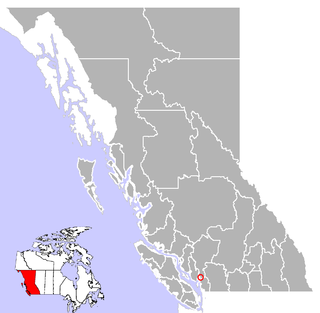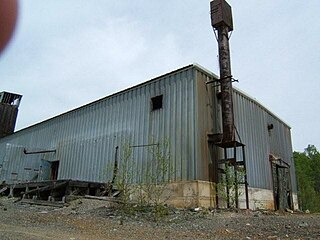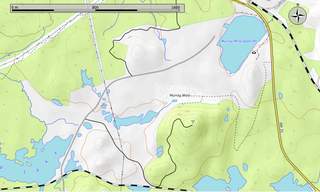 W
WBarton Mine, also known as Net Lake Mine, is an abandoned surface and underground mine in Northeastern Ontario, Canada. It is located about 0.50 km (0.31 mi) north of the Temagami Arena in Temagami North and just east of the Ontario Northland Railway in northwestern Strathy Township. Dating back to the early 1900s, it is one of the oldest mines in Temagami. Barton was the site of a fire in the early 1900s, after which it never had active mining again.
 W
WBritannia Beach is a small unincorporated community in the Squamish-Lillooet Regional District located approximately 55 kilometres north of Vancouver, British Columbia on the Sea-to-Sky Highway on Howe Sound. It has a population of about 300. It includes the nearby Britannia Creek, a small to mid-sized stream that flows into Howe Sound that was historically one of North America's most polluted waterways.
 W
WThe Brunswick #6 mine is a copper-lead-zinc mine in the Bathurst Mining Camp of northern New Brunswick, Canada. It was discovered in October, 1952 and was in production from 1966 until 1983. The Brunswick #6 orebody was the first major sulfide deposit discovered in the Bathurst area. The mine operated as an open-pit operation until 1977 when a ramp was driven from the bottom of the pit to access deeper ore.
 W
WThe Brunswick #12 mine is an underground lead-zinc-copper mine in the Bathurst Mining Camp of northern New Brunswick, Canada. It was discovered in January, 1953 and entered production in April, 1964. The Brunswick #12 orebody is the largest deposit in the Bathurst area and was one of the largest underground zinc mines in the world well into the late 1990s. The mine was officially closed at the end of April, 2013.
 W
WThe Caribou Mine is a copper-lead-zinc mine in the Bathurst Mining Camp of northern New Brunswick, Canada. It was discovered in 1955 and has seen several stages of development and production. The mine has changed ownership four times in the past 20 years.
 W
WCopperfields Mine, originally known as Temagami Mine, is an abandoned copper and silver mine on Temagami Island in Lake Temagami, Ontario, Canada. The mine opened in 1955 and comprises both underground and surface workings within a sulfide ore body. Situated in Phyllis Township, the mine produced 34,000,000 dollars Canadian with 80 million pounds of copper, 230,028 ounces of silver and 13,271 ounces of gold. It was considered to be the largest deposit of nearly pure chalcopyrite ever discovered in Canada. A mill was not initially needed because the ore was 28% copper. The mine closed in 1972 and is now flooded by water. Ruins of the Copperfields mill are present as foundations. It is possible to find mineral specimens in the spoil heaps of the old mine, such as chalcopyrite, pyrite, bornite, malachite, dolomite, hessite, merenskyite, millerite, palladium, quartz and others. The Lake Temagami Access Road was created to ship ore from the mine site.
 W
WCoppersand Mine is an abandoned copper mine in Temagami, Northeastern Ontario, Canada. It is located near the eastern shore of Ferguson Bay of Lake Temagami. A winter road from Sandy Inlet through Coppersand Lake was created to the mine in 1957. Subsequently, a small road, known as Miner's Road, was constructed off Kokoko Sideroad in 1970 to access the mine. Mining from the late 1950s to 1970s resulted in the creation of a small open pit.
 W
WThe Danlou Occurrence, also known as the Danlou Gold Occurrence and the Mortimer Occurrence, is a mineralized zone in Northeastern Ontario, Canada. Gold is the occurrence's primary commodity while copper and silver are secondary commodities. It occurs in a quartz vein within a diabase-porphyry shear zone. Pyrite and chalcopyrite are present in small amounts.
 W
WThe proposed Galore Creek mine is one of the largest undeveloped copper-gold deposits in Canada and in the world. The deposit is located in northwestern British Columbia. The deposit, situated within an alkalic, silica-undersaturated igneous intrusive complex, has estimated metal contents of 12 billion pounds of copper, 10.7 million oz of gold and 183.1 million oz of silver. It was owned 50% by Teck Resources and 50% by NovaGold Resources until 2018, when Newmont purchased NovaGold's share. The project lies in the traditional territory of the Tahltan First Nation.
 W
WHeath Steele Mines, situated 60 km northwest of Newcastle, New Brunswick, Canada, at the headwaters of the Tomogonops and Little Rivers, was a large and productive copper, lead and zinc mine which operated from 1956 to 1999. The mine was an economic cornerstone of Miramichi communities throughout this period.
 W
WThe Highland Valley Copper mine is the largest open pit copper mine in Canada, located near Logan Lake, British Columbia. It is an amalgamation of three historic mining operations: Bethlehem, Lornex and Highmont.
 W
WThe Kanichee Mine, also less commonly known as the Ajax Mine, is an abandoned base metal and precious metal mine, located in the Temagami region of northeastern Ontario, Canada. It is near the small unincorporated community of Temagami North, accessed by the Kanichee Mine Road from Highway 11. The Kanichee Mine zone has been explored and mined discontinuously from as early as 1910. During the 20th century, it operated and closed down at least three times, with the most recent being from 1973 to 1976. To date, the discontinuous operation of Kanichee Mine has produced 4.2 million pounds of metal.
 W
WKeeley-Frontier Mine is a large abandoned mine in the ghost town of Silver Centre, Northeastern Ontario, Canada. It consists of two underground mines that were sunk 1,455 ft (443 m) below the surface. Keeley Mine was discovered in 1907 while Frontier Mine was constructed in 1921. The 8th level of the Keeley Mine connected with the 6th level of the Frontier Mine in 1962, creating the two compartment Keeley-Frontier Mine. In 1965, Keeley-Frontier Mine closed with a total production of 19,000,000 oz (540,000,000 g) of silver, 3,300,000 lb (1,500,000 kg) of cobalt, 27,000 lb (12,000 kg) of nickel and 10,000 lb (4,500 kg) of copper.
 W
WThe Kemess Mine was an open-pit copper and gold mine, located just northeast of the foot of Thutade Lake, at the head of the Finlay River, in the Omineca Mountains of the Northern Interior of British Columbia, Canada. It was operated by Royal Oak Mines from 1998 to 1999, when it was bought by Northgate Minerals. Northgate operated the mine until its closure in 2011; that year Northgate was taken over by AuRico Gold. In 2014 AuRico Gold partitioned off its portion of Kemess Mine ownership creating a new company called AuRico Metals.
 W
WKidd Mine or Kidd Creek Mine is an underground base metal mine 24 km (15 mi) north of Timmins, Ontario, Canada. It is owned and operated by Swiss multinational Glencore Inc. The mine was discovered in 1963 by Texas Gulf Sulfur Company. In 1981 it was sold to Canada Development Corporation, then sold in 1986 to Falconbridge Ltd., which in 2006 was acquired by Xstrata, which in turn merged with Glencore in 2013. Ore from the Kidd Mine is processed into concentrate at the Kidd Metallurgical Site, located 27 km (17 mi) southeast of the mine, which until 2010 also smelted the ore and refined the metal produced. Following the closure of the majority of the Met Site, concentrate is now shipped to Quebec for processing. Kidd Mine is the world's deepest copper-zinc mine.
 W
WThe Murray Mine is a defunct nickel and copper mine in Greater Sudbury, Ontario. It was the site of the original ore discovery that led to the launch of mining operations in the Sudbury Basin area.
 W
WNorrie Mine is an abandoned surface mine in Northeastern Ontario, Canada. It is located about 1 km (0.62 mi) northeast of Temagami North on the eastern shore of Net Lake in eastern Strathy Township. It is named after L. B. Norrie of New York, who first claimed the mine site.
 W
WO'Connor Mine, also known as Milestone Mine, is an abandoned surface mine in Northeastern Ontario, Canada. It is located about 1 km (0.62 mi) southwest of the town of Temagami near the Northeast Arm of Lake Temagami in northern Strathcona Township. It is named after John O'Connor who first developed the mine site.
 W
WPhoenix Mine was an open pit and underground mining operation in city of Phoenix in the Boundary Country region of British Columbia, Canada that operated in the early and mid 20th century, run by the Granby Consolidated Mining, Smelting and Power Company. It was discovered in 1891, but was a lower grade copper deposit than the Rossland and Slocan deposits. The low grade and the nearest railroad being 75 miles (121 km) resulted in the Phoenix receiving less attention.
 W
WPriest Mine is an abandoned surface and underground mine in Northeastern Ontario, Canada. It is located about 19 km (12 mi) northwest of the hamlet of Marten River on an island in north-central Cross Lake. Dating back to the early 1900s, it is one of the oldest mines in the municipality of Temagami.
 W
WTemagami-Lorrain Mine is an abandoned surface and underground mine in Northeastern Ontario, Canada. It is located about 10 km (6.2 mi) northeast of the town of Temagami near Sauvé Lake in central Cassels Township. It is named after the Temagami-Lorrain Mining Company, which carried out work on the property in the early 1900s.
 W
WThe Wedge Mine was a copper mine in the Bathurst Mining Camp of Northeast New Brunswick. It was owned and operated by Cominco on the north bank of the Nepisiguit River. The mine was discovered in 1956 and in operation from 1962 to 1968 producing 1.5 million tonnes of ore. The ore was trucked to, and milled at the Heath Steele Mine. Only the copper rich part of the deposit was mined.